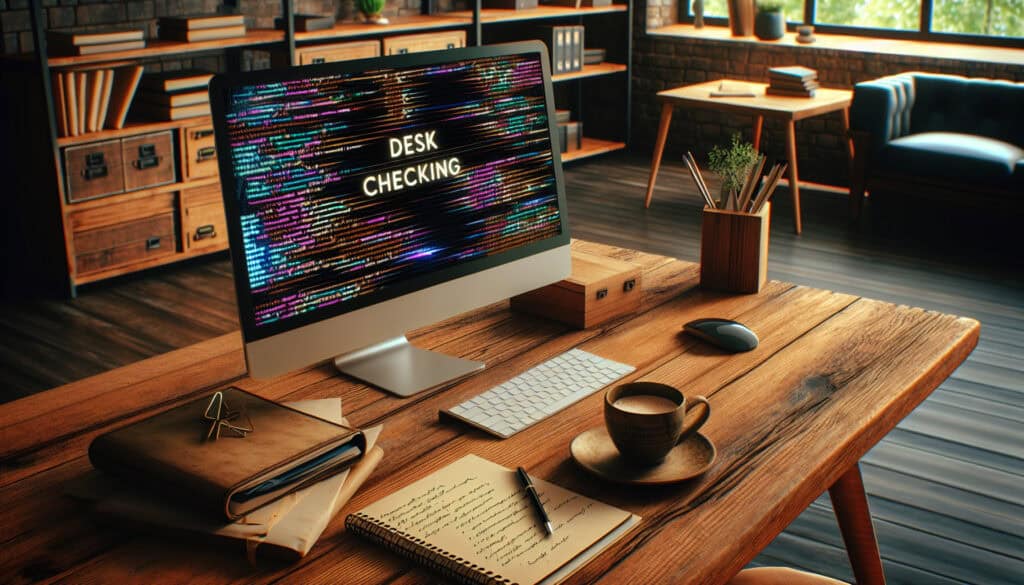An informal, manual process of reviewing one’s own source code or logic before it is compiled or executed.
- Metodologie: Ingegneria, Ergonomia
Desk Checking

Desk Checking
- Metodologia agile, Miglioramento continuo, Prevenzione degli errori, Garanzia di qualità, Controllo di qualità, Ingegneria del software, Test del software, Validazione, Verifica
Obiettivo:
Come si usa:
- A developer sits at their desk and mentally walks through the logic of their code, line by line, to spot errors. It is the most basic form of code review.
Professionisti
- Is simple, quick, and requires no special tools; helps developers catch simple mistakes before they affect others.
Contro
- It is easy for developers to overlook their own errors due to familiarity with the code; it is not a substitute for a formal peer review or systematic testing.
Categorie:
- Ingegneria, Qualità
Ideale per:
- A developer performing a manual, mental run-through of their own code to catch obvious errors.
Desk Checking is often employed in software development, particularly during the design and testing phases of a project, where developers meticulously review their own code to identify logical flaws or typographical errors before deploying the product. This technique not only serves individual developers but can also be effectively implemented in collaborative environments where team members engage in peer reviews. In industries such as finance, aerospace, and healthcare, where precision is paramount, the practice of Desk Checking becomes even more significant as a preemptive measure against costly errors or system failures. Participants typically include software engineers, quality assurance testers, and technical leads who can contribute different perspectives during the code verification process. The application of this methodology doesn’t require elaborate tools or platforms, making it an accessible practice in both established companies and startups, especially in agile development settings. Desk Checking also promotes a culture of accountability, encouraging developers to take ownership of their code by mentally rehearsing its execution, which can lead to more robust and reliable software solutions. Encouraging this practice early in the development cycle can save time and resources, thus enhancing project efficiency and ensuring the overall quality of the final product.
Fasi chiave di questa metodologia
- Read each line of code carefully, visualizing its execution.
- Identify and mentally track variable values as the code runs.
- Check conditional statements and loops for logical errors.
- Verify that function calls and their parameters are correct.
- Look out for off-by-one errors in iterations or index handling.
- Consider edge cases and how the code handles them.
- Check for unused variables or redundant code.
- Evaluate the code's flow and structure for readability.
- Reflect on consistency in naming conventions and formatting.
- Mentally replay scenarios to ensure expected outcomes occur.
Suggerimenti per i professionisti
- Focus on boundary conditions and edge cases during your mental walkthrough to ensure robustness against unexpected inputs.
- Incorporate peer feedback into your desk checking by verbalizing your logic to a colleague, which can surface hidden assumptions.
- Document your desk-checking thought process for future reference; this can be invaluable for recognizing recurring patterns in errors.
Leggere e confrontare diverse metodologie, raccomandiamo il
> Ampio archivio di metodologie <
insieme ad altre 400 metodologie.
I vostri commenti su questa metodologia o ulteriori informazioni sono benvenuti su sezione commenti qui sotto ↓ , così come tutte le idee o i link relativi all'ingegneria.
Contesto storico
1828
1850
1854
1854
1911
1928
1950
1827
1848
1850
1854
1895
1914
1943
1970
(se la data non è nota o non è rilevante, ad esempio "meccanica dei fluidi", viene fornita una stima approssimativa della sua notevole comparsa)















Post correlati
Simulazione di Monte Carlo
Test basati su modelli
Controllo del modello
Ricerca con metodi misti
A prova di errore (Poka-Yoke)
Test del profilo di missione